Have you ever wondered why tiger barbs have remained a favorite among aquarium enthusiasts for over three decades?
Their lively demeanor and hardiness could be the answer!

Originating from Borneo, Sumatra, and the Malay Peninsula, these chubby barbs have adapted to different water conditions found in their native region.
From clear streams to muddy swamps, tiger barbs have shown that they can survive and even flourish in various aquatic environments.
One thing that often comes up in discussions about tiger barbs is their reputation as fin-nippers. While it’s true that they can be a bit territorial, they are far from being bloodthirsty killers.
With proper care and attention, these fish can live peacefully alongside other species in your aquarium.
So, if you’re looking for a lively and hardy fish species that will add a splash of color to your aquarium, the tiger barb is an excellent choice!
At a glance
| Min tank size: | 20 gal (80 l) |
| School Size: | 10+ |
| Water temperature: | 68-82°F (20-28°C) |
| Lifespan: | 5 years |
| Size: | 2.5-3 inches (6-7.6 cm) |
| pH: | 6.0-8.0 |
| Ammonia: | 0 ppm |
| Nitrite: | 0 ppm |
| Nitrate: | <20 ppm |
In this article
What’s in a Name?
First classified by Pieter Bleeker in 1855 as Barbus tetrazona, these fish have gone through quite an identity crisis. They’ve been classified and reclassified nearly half a dozen times and have belonged to four different genera.
While the scientific community is still debating whether the Barbus or Barbodes genera can even be clearly defined, the tiger barb currently belongs to the genus Puntigrus in the Cyprinidae family.
Its scientific name, Puntigrus tetrazona, is aptly given. Puntigrus is similar to the latin tigris, meaning tiger, with the species name tetrazona referencing their four stripes.
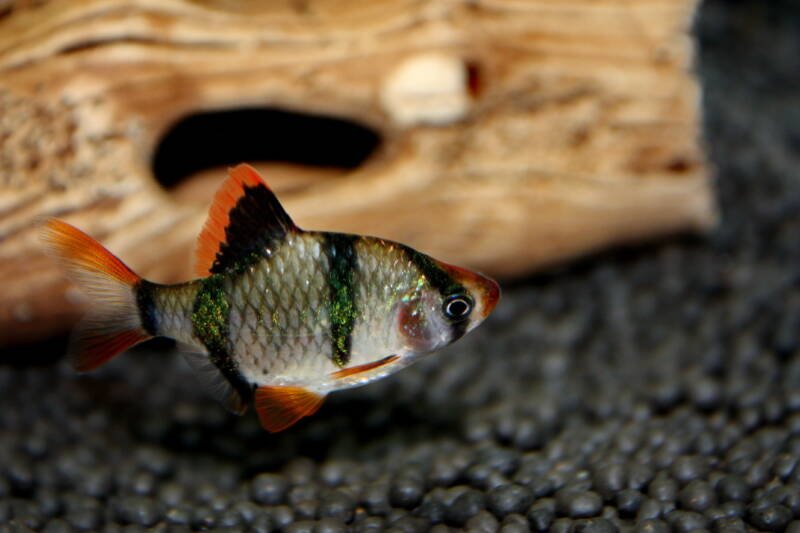
With their orange bodies and thick black stripes, it’s no wonder they’re commonly referred to as tiger barbs.
These barbs are also commonly sold under the name Sumatra barb or partbelt barb. The green color form of this fish is usually referred to as the green tiger barb or moss tiger barb.
Varieties
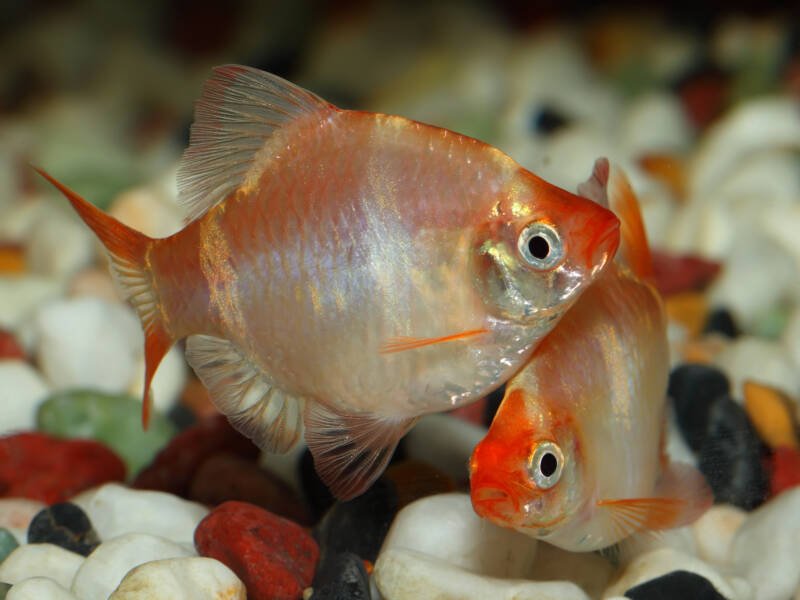
Traditional black and orange striped tiger barbs are absolutely iconic. Easily recognizable and available in any and every fish store from mom-and-pop to big box shops.
If classic tigers aren’t your thing, though, these barbs also come in a variety of other colors and patterns. There’s an albino color form, a green color form, and GloFish® has also recently come out with neon yellow and red!

The green tiger barbs have a subtle iridescence which really stands out when you keep a large school of them. You can also find green tiger barbs with varying degrees of green coverage.
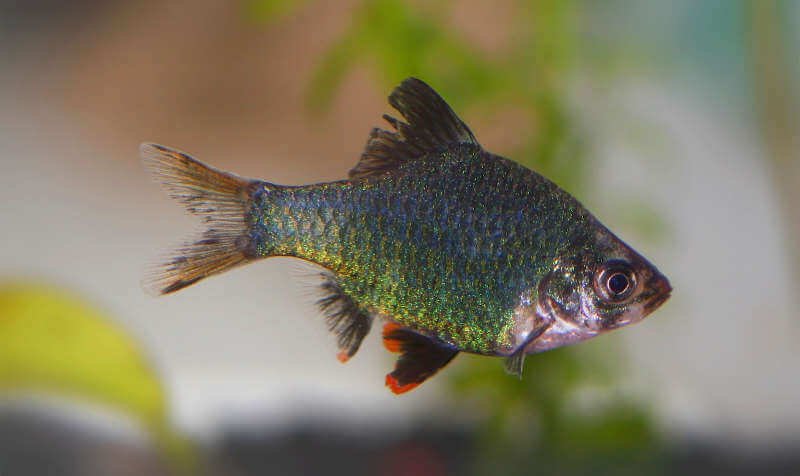
Some will be completely green, like the one above, and others will just have green splotches or stripes.
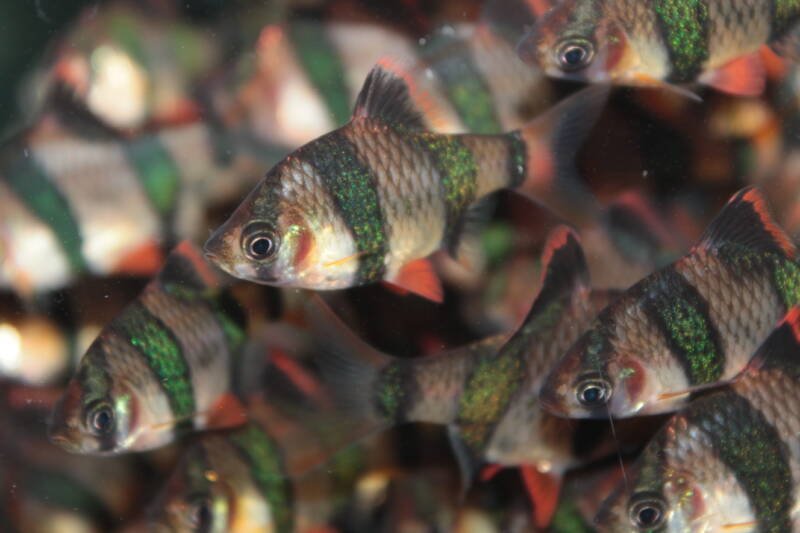
Behavior
I think these fish get a bad rap for being aggressive. While they don’t always play particularly well with others, they’re certainly not blood-thirsty killers either.
Tiger barbs will establish a pecking order by nipping and chasing. This is completely normal and nothing to worry about. When it comes to tank mates, though, they’ll also nip. For the most part, this stresses other fish out, so keep this in mind when considering tank mates.
These barbs are extremely active fish. There’s always movement in the tank, and they’re mesmerizing to watch. On occasion, they’ll school together back and forth across the tank, which looks impressive with a large group.
If you’re looking for a mid-size, active fish to create a display tank with, these fish just might be right for you!
Care Overview

Because these fish are curious and active, they’ll need a mid to large size aquarium; the bigger the better.
I personally wouldn’t recommend anything smaller than twenty gallons (76 l), with thirty to fifty-five gallons being more adequate for larger groups.
I’d start out with a group of at least ten or so for a twenty-gallon and increase the school size for larger tanks.
Tiger barbs are extremely hardy, adaptable fish. They’ll tolerate a wide range of pH and temperature, but they do best when kept at a pH of 6.5-7.5 and a temperature of 75-80°F (24-27°C).
Just because they’re hardy doesn’t mean you should neglect their water quality, though. Like all other fish, they should be kept in a cycled tank with plenty of cover and décor.
Weekly water changes should be performed to keep nitrates at 20ppm or under to ensure water quality. When properly cared for, partbelt barbs can live up to five years and grow up to 3 inches (7.6 cm).
Tank Setup

Supplies
- 20+ gallon aquarium (76 l)
- Stand
- Lighting
- Filter
- Heater
- Thermometer (glass or digital)
- Substrate
- Décor
- Water change equipment
- Water conditioner
- Water test kit
Aquarium & Stand
Sumatra barbs are active. They tend to use the middle layer of the water column and are well suited to long aquariums. They’ll do okay in tall tanks too, though.
Regardless of tank dimensions, ensure that your aquarium has a level, sturdy stand or platform to sit on.
Lighting, Heating & Filtration
These barbs aren’t picky about lighting, so anything from shop lights to top-of-the-line LEDs will do.
If you have a planted tank, choose lighting according to your plants’ needs. If you’re on a budget, Nicrew brand lights are fantastic.
Fluval and Current USA’s lights are a little pricier but offer more intense LED lights, which are great for plants with high lighting needs.
These fish are tropical, and while they do tolerate lower temperatures, an adjustable heater will help keep them comfy and warm.
There are plenty of heaters available on the market to choose from, whether in-store or online. These heaters are budget-friendly while Fluval and Cobalt remain popular brand-name choices.
Substrate & Décor
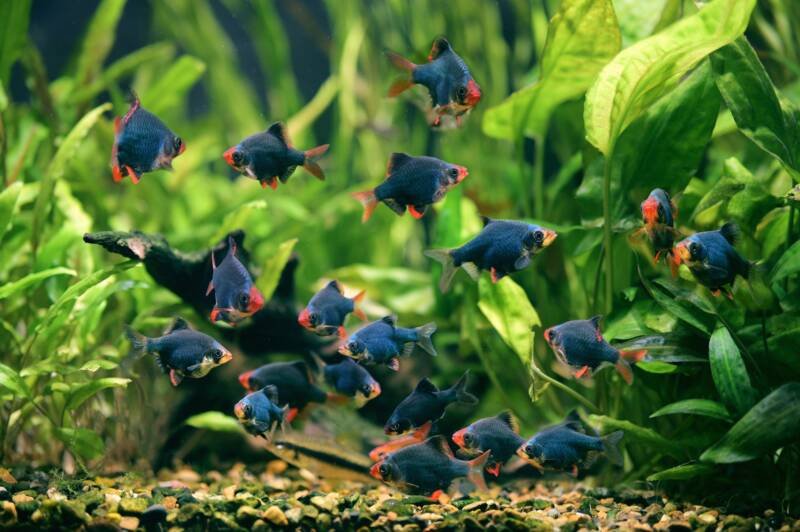
If you’ve read any of my other articles, you’ll know that my biggest weakness is a well-planted tank. The reason is that, for so many fish, this replicates their natural habitat and provides plenty of cover. Plants also help keep nitrates low and water parameters stable.
Tiger barbs aren’t picky about substrate and will do well with sand, gravel, or plant substrate. If you’ve got plants, I’d recommend choosing substrate that meets their needs.
I know planted tanks can be somewhat intimidating, but there are plenty of low-light, low-maintenance plants out there!
Anubias is a great option if you have a lot of hardscape as it can be glued or tied to wood and rocks.
Swords are great for taller tanks with plenty of substrate for their root systems. Crypts are also easy to grow and come in various sizes and colors.
Whether you choose to plant your tank or not, at the end of the day the goal is to make sure that your fish have plenty of cover and territory to explore. If you can give them that, you’re golden.
Tank Maintenance
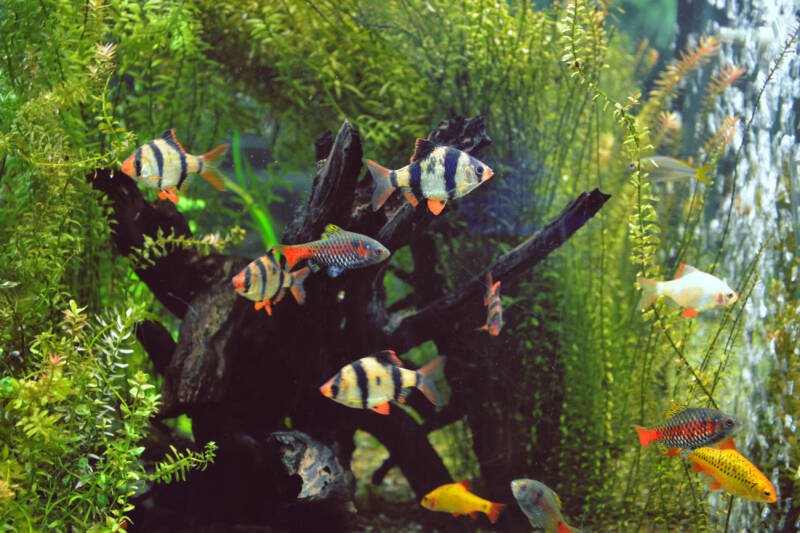
In order to properly maintain your aquarium, you’ll need to perform regular water changes. Water changes help to keep nitrates low.
You can measure these and other water parameters with a test kit. You can also find test strips, but liquid test kits are more accurate.
Bigger tanks mean bigger water changes, so a siphon and a big bucket will be your best friends.
If your tank is far away from your sink or you can’t lift heavy objects, consider investing in a python water changer (not only will it change your water, it’ll change your life). When adding in fresh water, make sure to use water conditioner.
If you’ve got hungry plants after a water change is the perfect time to replenish nutrients with liquid fertilizers.
Diet
These fish don’t get super big, but they sure can eat! As omnivores, they’ll accept a variety of dried, frozen, and live foods.
I always recommend a varied diet when possible. Rotating the foods you’ve got on hand or investing in some frozen or live foods in addition to a dry staple diet will do your fish some good.
You can also offer some fresh or blanched veggies from time to time. Zucchini seems to be popular!
Feeding high-quality, protein-packed foods is especially important if you’re planning to breed these barbs. Adult females will end up plump and round before spawning, and fry will readily accept freshly hatched baby brine shrimp along with bits of flakes.
Tank Mates and Stocking

Before I jump into tank mates suggestions, I want to let y’all know that ideally these fish would be kept in a species-only tank.
While they’re not aggressive, they are curious and will pick at any and everything.
They fear nothing and will not hesitate to pick on fish three or four times their own size. Sometimes this is enough to stress tank mates to death, literally.
Now, this isn’t to say that tiger barbs can’t have tank mates. But it is important to be aware of the possible risks involved.
When creating a community tank, just keep in mind the needs of all community members and make necessary changes to stocking if issues arise.
With all that said, here are some examples of tank mates some people have had success with:
- Serpae tetras can be equally nippy and seem to be able to hold their own when housed with Sumatra barbs.
- Clown loaches have a similar color and pattern to tiger barbs and seem to be a popular tankmate. Keep in mind, though, that clown loaches need a lot of space and get quite large.
- Related barbs, such as Odessa barbs or rosy barbs are popular tank mate choices since they have similar care requirements and temperament.

If you’re looking for more variety in your stock but still want a species-only tank, you can keep different colored tiger barbs together with no issues.
You want to throw in a few green barbs for good measure? You’re good to go. Do you want a skittles mix with a few of every available variety? Go for it!
Sexing
When it comes to sexing tiger barbs, looking for subtle differences is key.
While males and females both have those iconic black stripes, males tend to have more intense red coloration: a red nose, a red stripe along the edge of their dorsal fin, and a pair of bright red pelvic fins.

Females may have some faint coloration in these areas as well, but it will be much duller when compared to the males. Females also tend to be much rounder than their male counterparts.
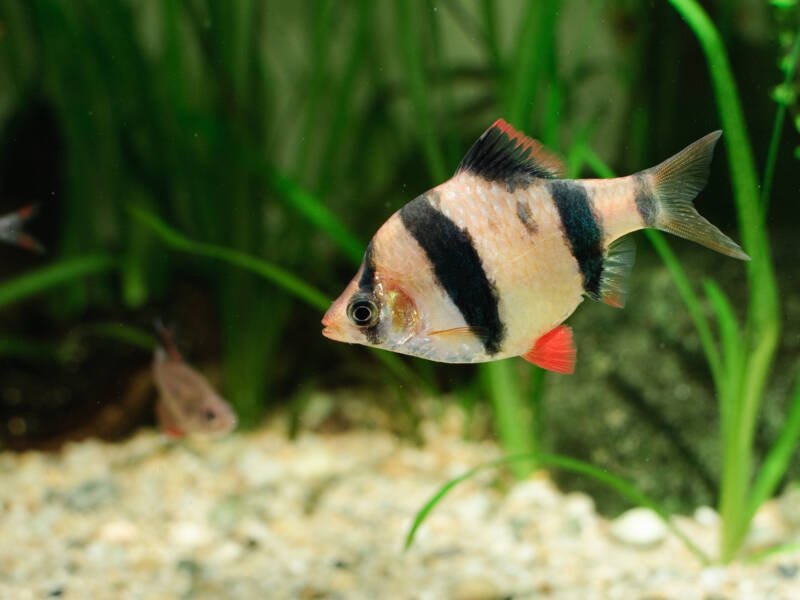
Breeding
In order to raise a hefty batch of fry, you’ll need to set up some breeding tanks separate from your main aquarium. Your adult barbs may spawn in their display tank, but they’ll also eat their eggs and fry so only a few (if any) young will survive to adulthood.
To ensure you end up with fry, breeding them outside of their display tank is highly recommended.
There are plenty of different ways to set up spawning tanks, but I’m a fan of having at least three separate ones. One for the males, one for the females, and then a tank for the actual spawning and grow out.
The adult tanks should have some cover but should also be easy to clean since you’ll be feeding heavily.
The bottom of the spawning tank should be covered with marbles (two layers thick should do) so eggs will fall down into the marbles and the adults won’t be able to eat them.
Adding bunched, floating plants like cabomba to this tank will also help with the spawning process and give extra cover to the fry once they hatch.
Conditioning
In order to breed these barbs, they need to go through a conditioning process, which involves separating the males from the females.
Twenty – or thirty-gallon tanks should suffice (males in one, females in the other). Keeping these tanks at 80°F (27°C) seems to produce the best results.
Now that you’ve got your males sorted from your females feed a protein-heavy diet (blood worms, tubifex, brine shrimp, etc.) for the next 3 to 4 days. The goal is to fatten up your females and get the males to show their bright red spawning coloration.
Feed the tanks at least twice a day and do 20-30% water changes daily to maintain water quality.
Spawning
After conditioning, you can move all the adults into the spawning tank. This tank should be heated to 80°F or 27°C, just like the conditioning tanks.
If you place the adults into the tank in the early evening, they should breed around dawn the next day.
Keep an eye on the tank, checking daily for eggs and spawning behavior.
These fish scatter their eggs, so the females will lay their eggs, and males will follow behind to fertilize them. Continue to feed high-protein foods during this time as well.
Remove adults once they’ve finished breeding and place them back into your display tank.
Grow Out
Now that you’ve successfully bred your barbs, it’s time to grow out your fry.
After three to four days, the eggs should begin to hatch. After hatching, the fry will feed on their yolk sacks. Around day five or so, you should have a few tiny free-swimming fry.
When you begin to see free-swimming fish, you can also begin to feed high-quality foods like freshly hatched baby brine shrimp and daphnia.
Crushed flakes are acceptable to feed but must be accompanied by a higher-nutrient food as flakes do not have enough nutrients to sustain the fry properly.
Don’t forget to keep up with water changes during the grow-out process. Daily water changes coupled with constant, gentle aeration should help keep fungus at bay. Aeration can be provided by an air stone or sponge filter.
After ten to fourteen days, you should be able to start moving fry to other grow-out tanks.
Remember those two tanks you used to condition the males and females? You can repurpose those for growing out fry. Because females can lay a couple hundred eggs at a time, you’ll want as much grow-out space as possible.
As the fry grow, slowly wean them onto whatever you’re feeding your adult barbs (whether that’s high-protein dry foods or a wider variety of foods).
They’ll reach maturity at around six or seven weeks when they’re just over an inch long (2.5 cm).
What you do with the adults is up to you. You can add them to your display tank, give them to local hobbyists, or even sell them to your local aquarium shop.
Disease
The best medicine is prevention. Maintaining good water quality with regular water changes and keeping tank parameters consistent goes a long way. Even when we do our best, though, fish can still get sick.
While there aren’t any illnesses specific to tiger barbs, they’re susceptible to common illnesses such as ich (Ichthyophthirius multifiliis) and dropsy.
Ich
Ich is an external parasite that resembles grains of salt sprinkled all over the fish. It reproduces very quickly. If you catch it early, you’ll have a better chance of treating it successfully.
These fish can tolerate higher temperatures, so cranking the heat up to 86°F or 30°C will speed up the parasite’s life cycle.
Higher temperatures combined with aquarium salt and medication (like Ich-X) will help to kill off the parasite in its early life stages. Extra oxygenation (from an air stone or sponge filter) and water changes are also recommended.
Dropsy
Dropsy is a set of symptoms accompanying organ failure usually caused by an internal infection.
Telltale signs of dropsy include pineconing (raised scales, making the fish resemble a pinecone), extreme bloat, and difficulty swimming. These symptoms are caused by a buildup of fluid inside the fish.
By the time symptoms show, the disease has progressed too far along to be cured most of the time.
Euthanizing affected fish should be considered strongly. If caught early enough, though, you may be able to try treating with Epsom salts and antibiotics such as kanaplex.
Happy Fishkeeping!
You made it to the end, thank you so much for reading! If you’ve kept tiger barbs, what was your experience with them?
If you want to keep them in the future, what are you looking forward to most about keeping them? As always, comments and criticisms are welcome down in the comments!
Good luck and happy fishkeeping y’all!